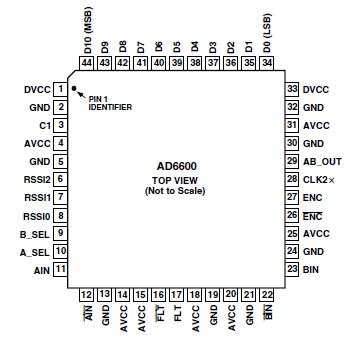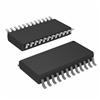Features: ` Dual IF Inputs, 70 MHz250 MHz
Diversity or Two Independent IF Signals
Separate Attenuation Paths
` Oversample RF Channels
20 MSPS on a Single Carrier
10 MSPS/Channel in Diversity Mode
` Total Signal Range 90+ dB
30 dB from Automatic Gain-Ranging (AGC)
60 dB from A/D Converter
Range >100 dB After Processing Gain
` Digital Outputs
11-Bit ADC Word
3-Bit RSSI Word
2*Clock, A/B Indicator
` Single 5 V Power Supply
Output DVCC 3.3 V or 5 V
` 775 mW Power DissipationApplication·Communications Receivers
·PCS/Cellular Base Stations
GSM, CDMA, TDMA
·Wireless Local Loop, Fixed AccessPinout Specifications
Specifications
| Parameter |
Min |
Max |
Unit |
ELECTRICAL
AVCC Voltage
DVCC Voltage
Analog Input Voltage AVCC 2
Analog Input Current2
Digital Input Voltage AVCC 3
Output Current 4
Resonant Port Voltage5 |
0
0
0
0 0
|
7
7
AVCC
25
AVCC
4
AVCC |
V
V
V
mA
V
mA
V |
ENVIRONMENTAL6
Operating Temperature Range
(Ambient)
Maximum Junction Temperature
Lead Temperature (Soldering,sec)
Storage Temperature Range (Ambient) |
-40
-65
|
+85
150
300
+150
|
|
NOTES
1Absolute maximum ratings are limiting values to be applied individually, and
beyond which the serviceability of the circuit may be impaired. Functional
operability is not necessarily implied. Exposure to absolute maximum rating
conditions for an extended period of time may affect device reliability.
2Pins AIN, AIN, BIN, BIN.
3Pins ENC, ENC, A_SEL, B_SEL.
4Pins D10:0, RSSI2:0, AB_OUT, CLK2*.
5Pins FLT, FLT.
6Typical thermal impedance (44-lead LQFP); JC = 16°C/W, JA = 55°C/W.DescriptionThe AD6600 mixed-signal receiver chip directly samples signals at analog input frequencies up to 250 MHz. The device includes two input channels, each with 1 GHz input amplifiers and 30 dB of automatic gain-ranging circuitry. Both channels are sampled with a 450 MHz track-and-hold followed by an 11-bit, 20 MSPS analog-to-digital converter. Digital RSSI outputs, an A/B channel indicator, a 2* Clock output, references, and control circuitry are all on-chip. Digital output signals are two's complement, CMOS-compatible and interface directly to 3.3 V or 5 V digital processing chips.
The primary use for the dual analog input structure of AD6600 is sampling both antennas in a two-antenna diversity receiver. However, Channels A and B may also be used to sample two independent IF signals. Diversity, or dual-channel mode, is limited to 10 MSPS per channel. In single-channel mode, the full clock rate of 20 MSPS may be applied to a single carrier.
The AD6600 may be used as a stand-alone sampling chip, or it may be combined with the AD6620 Digital Receive Signal Processor. The AD6620 provides 10 dB25 dB of additional processing gain before passing data to a fixed- or floating-point DSP.
Driving the AD6600 is simplified by using the AD6630 differential IF amplifier. The AD6630 is easily matched to inexpensive SAW filters from 70 MHz to 250 MHz.
Designed specifically for cellular/PCS receivers, the AD6600 upports GSM, IS-136, CDMA and Wireless LANs, as well as proprietary air interfaces used in WLL/fixed-access systems. Units are available in plastic, surface-mount packages (44-lead LQFP) and specified over the industrial temperature range (40°C to +85°C).

 AD6600 Data Sheet
AD6600 Data Sheet








